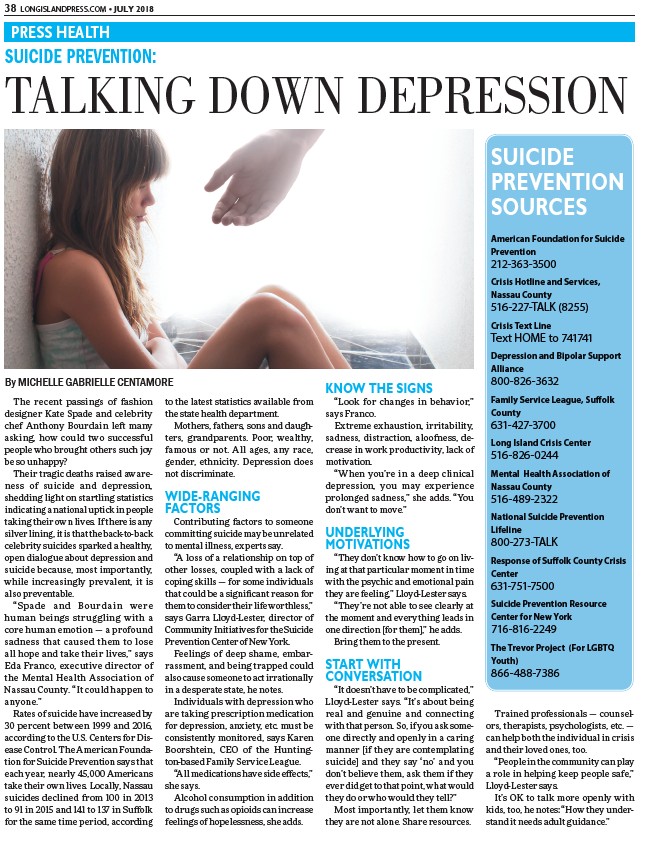
38 LONGISLANDPRESS.COM • JULY 2018
SUICIDE PREVENTION:
TALKING DOWN DEPRESSION
The recent passings of fashion
designer Kate Spade and celebrity
chef Anthony Bourdain left many
asking, how could two successful
people who brought others such joy
be so unhappy?
Their tragic deaths raised awareness
of suicide and depression,
shedding light on startling statistics
indicating a national uptick in people
taking their own lives. If there is any
silver lining, it is that the back-to-back
celebrity suicides sparked a healthy,
open dialogue about depression and
suicide because, most importantly,
while increasingly prevalent, it is
also preventable.
“Spade and Bourdain were
human beings struggling with a
core human emotion — a profound
sadness that caused them to lose
all hope and take their lives,” says
Eda Franco, executive director of
the Mental Health Association of
Nassau County. “It could happen to
anyone.”
Rates of suicide have increased by
30 percent between 1999 and 2016,
according to the U.S. Centers for Disease
Control. The American Foundation
for Suicide Prevention says that
each year, nearly 45,000 Americans
take their own lives. Locally, Nassau
suicides declined from 100 in 2013
to 91 in 2015 and 141 to 137 in Suffolk
for the same time period, according
to the latest statistics available from
the state health department.
Mothers, fathers, sons and daughters,
grandparents. Poor, wealthy,
famous or not. All ages, any race,
gender, ethnicity. Depression does
not discriminate.
WIDE-RANGING
FACTORS
Contributing factors to someone
committing suicide may be unrelated
to mental illness, experts say.
“A loss of a relationship on top of
other losses, coupled with a lack of
coping skills — for some individuals
that could be a significant reason for
them to consider their life worthless,”
says Garra Lloyd-Lester, director of
Community Initiatives for the Suicide
Prevention Center of New York.
Feelings of deep shame, embarrassment,
and being trapped could
also cause someone to act irrationally
in a desperate state, he notes.
Individuals with depression who
are taking prescription medication
for depression, anxiety, etc. must be
consistently monitored, says Karen
Boorshtein, CEO of the Huntington
based Family Service League.
“All medications have side effects,”
she says.
Alcohol consumption in addition
to drugs such as opioids can increase
feelings of hopelessness, she adds.
KNOW THE SIGNS
“Look for changes in behavior,”
says Franco.
Extreme exhaustion, irritability,
sadness, distraction, aloofness, decrease
in work productivity, lack of
motivation.
“When you’re in a deep clinical
depression, you may experience
prolonged sadness,” she adds. “You
don’t want to move.”
UNDERLYING
MOTIVATIONS
“They don’t know how to go on living
at that particular moment in time
with the psychic and emotional pain
they are feeling,” Lloyd-Lester says.
“They’re not able to see clearly at
the moment and everything leads in
one direction for them,” he adds.
Bring them to the present.
START WITH
CONVERSATION
“It doesn’t have to be complicated,”
Lloyd-Lester says. “It’s about being
real and genuine and connecting
with that person. So, if you ask someone
directly and openly in a caring
manner if they are contemplating
suicide and they say ‘no’ and you
don’t believe them, ask them if they
ever did get to that point, what would
they do or who would they tell?”
Most importantly, let them know
they are not alone. Share resources.
Trained professionals — counselors,
therapists, psychologists, etc. —
can help both the individual in crisis
and their loved ones, too.
“People in the community can play
a role in helping keep people safe,”
Lloyd-Lester says.
It’s OK to talk more openly with
kids, too, he notes: “How they understand
it needs adult guidance.”
PRESS HEALTH
SUICIDE
PREVENTION
SOURCES
American Foundation for Suicide
Prevention
212-363-3500
Crisis Hotline and Services,
Nassau County
516-227-TALK (8255)
Crisis Text Line
Text HOME to 741741
Depression and Bipolar Support
Alliance
800-826-3632
Family Service League, Suffolk
County
631-427-3700
Long Island Crisis Center
516-826-0244
Mental Health Association of
Nassau County
516-489-2322
National Suicide Prevention
Lifeline
800-273-TALK
Response of Suffolk County Crisis
Center
631-751-7500
Suicide Prevention Resource
Center for New York
716-816-2249
The Trevor Project (For LGBTQ
Youth)
866-488-7386
By MICHELLE GABRIELLE CENTAMORE